Jasmund Bodden and Co: The Bodden areas on Rügen - ideal for nature lovers
Lasse Johannsen
· 26.11.2023
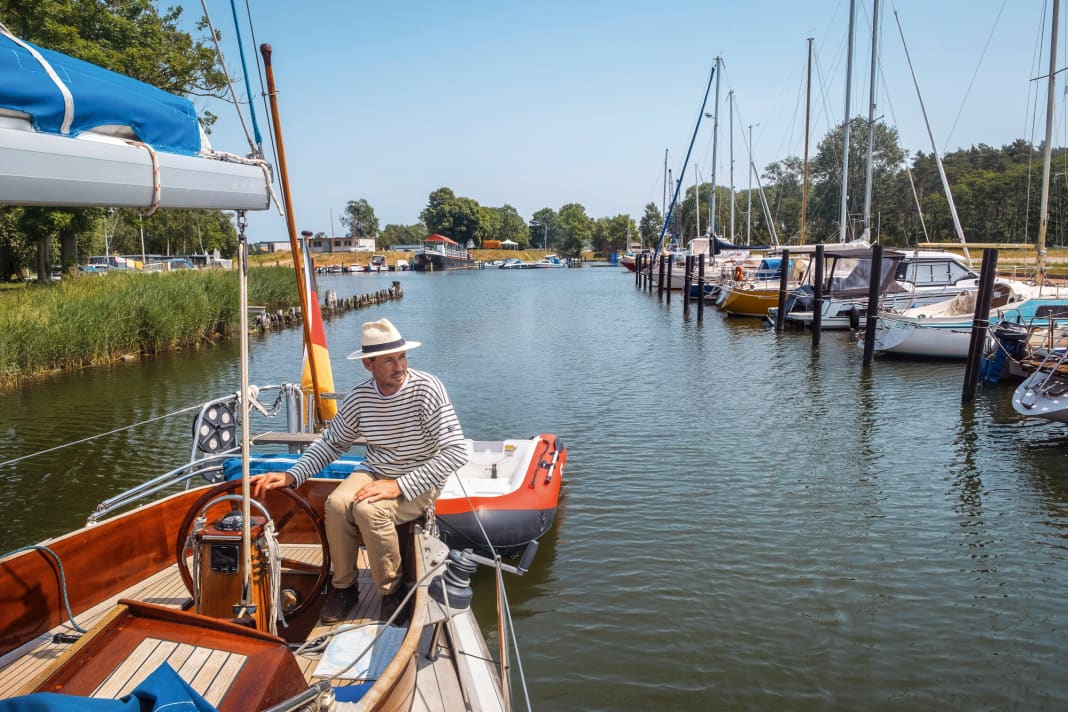





Midsummer. The sun burns down mercilessly on the Dornbusch, the beacon at the northern tip of Hiddensee. The sea in front of it is rough, a swell makes the boat roll, sails beat in the weak wind. From here, the "dead guy", as the steep bank below the 95 metre high beacon is called, offers an impressive sight. It is the first of the areas we have travelled to - and the last where open water can be seen.
Now we are heading south, and when we reach the first pair of buoys in the channel that leads into the Bodden waters between Hiddensee and Rügen's north-western peninsula of Bug, we have to keep an eye on the numerous buoys.
After rounding the Buger Haken, the course is easterly. We head for the northern inland waters of the island of Rügen, the Wieker, Breetzer, Breeger, Lebbiner and Großer Jasmund Bodden. A journey into sparsely populated nature and an enchanting landscape - the "Western Pomerania Bodden Landscape National Park and Jasmund National Park".
The Bodden landscape is a micro-region with many bays and inlets
This is a micro-region of over half a dozen bays, inlets and bays connected by narrow channels, a paradise for nature lovers and anchor enthusiasts. And although the distance from one end to the other is only around 20 nautical miles, you can easily spend a week in these sheltered waters without getting bored.
The water becomes calm in the shelter of the banks that reach right up to the channel, and the ship only moves thanks to the pressure of the wind. The soundscape changes from the sound of the sea to the rustling of the reeds swaying in the wind on the shore and the twittering of the birds. Coming from the sea, this new image is intoxicating. Because it is not just visible in the distance, but because, on the contrary, you are sailing right into it.
The anchor drops in the mild evening light off Grubnow in the Lebbiner Bodden. The contrast could hardly be greater. Whereas during the day the view from the cockpit was across the open sea, now there are vast fields of reeds to be seen. Boats with a draught of less than 1.30 metres can also reach the small jetty. But the anchorage is good and the place, which is nothing more than a name on the map and a hut on the jetty, is quickly reached by dinghy.
An association looks after the idyllic site, which offers a barbecue area and terrace as well as toilets and water. However, the landlady of the old fisherman's house, who is praised in the guidebook and who spoils guests with smoked fish and homemade apple pie, has long been a legend.
More wind creates a short, steep wave on the Bodden
Dark clouds gather the next morning. A summer thunderstorm breaks out over the Lebbiner Bodden. Only when it has passed through do we weigh anchor. As the wind picks up, the Great Jasmund Bodden shows what it can do on the way to Ralswiek: Within a very short space of time, a short, steep sea builds up on the water, which is only six to seven metres deep and would make life difficult for the crews of smaller boats.
The formation of these bays was not so long ago in geological terms. The Ice Age initially left a rugged landscape here, which only filled with water around 7,000 years ago during a post-glacial rise in sea level. At that time, Rügen resembled an archipelago of numerous small islands. Only after centuries of sediment movement at the bottom did many culverts close. The landscape of lagoons, bays and inlets was created.
Although sailors will find a unique natural experience in this extensive region, there are not many marinas here - but there are sheltered anchorages wherever you look. So if you have the time, you can forget all about it while strolling from bay to bay. The marinas for pleasure craft are mostly former fishing harbours that have been expanded to include a few berths and a jetty for passenger boats without creating a large marina.
Pirates used to hide on the Bodden
One such harbour is Ralswiek. It is located at the southern end of the Great Jasmund Bodden and has everything your heart desires - if you can find a place. Not least because of its idyllic location, it attracts many boat tourists during the season. There is water and electricity on the jetties, toilets and showers, two restaurants in the harbour and a bike hire service.
Ralswiek is the first documented settlement on Rügen and was once an important trading centre. From 1168, the island was under the feudal sovereignty of the Danish King Waldemar I. Ralswiek became a provostry of the bishops of Roskilde, which still stands today. The castle, on the other hand, dates back to 1893 and was built for a Scottish-born earl, was a sanatorium during the GDR era and now houses a hotel.
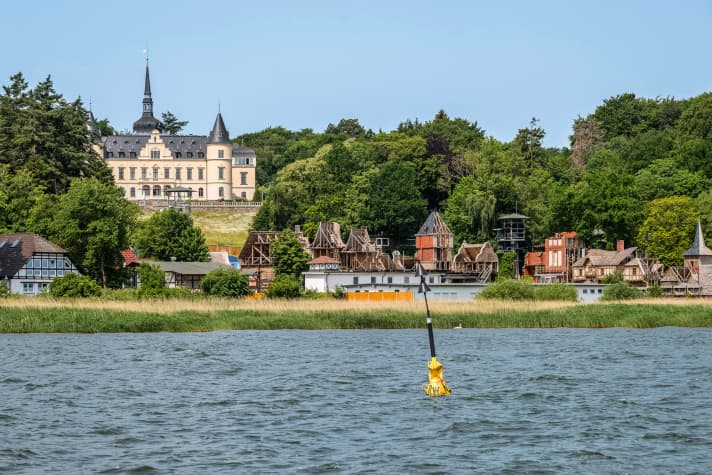
Ralswiek is known far beyond its borders for the annual Störtebeker Festival. Whether Klaus Störtebeker, the 14th century ringleader of the Vitalienbrüder, really came from Rügen is not known. What is certain is that the Bodden waters served as a hideout for pirates who made trading on the North and Baltic Seas difficult for merchants during the Hanseatic League.
The festival was first held in 1993 and, along with the castle, is now the town's main attraction for tourists. The castle and festival stage are clearly visible from the lake. Lying in the harbour, you can hardly escape the performance. You can hear the inevitable firecrackers, see the pirate ships actually approaching and landing over the water for the invasion and the eagles, falcons and buzzards regularly flying over the heads of the audience. A visit to a performance is just as worthwhile as a visit to the castle.
On the way there, the 26.5 metre long steel cutter "Elbe", built in 1955, is moored and owner Harloff serves fresh smoked fish every day on his "smoker ship". The chef stands on the forecastle and cuts halibut from Greenland into portion-sized pieces. "I've been doing this here for 25 years," he says and lists everything he puts in the oven: salmon, butterfish, eel, mackerel. "The customers have remained loyal to me," says Harloff.
Martinshafen, Glowe, Breege- The choice of destinations is large
The journey continues to Martinshafen. The harbour of Lietzow, in the south-east corner of the Bodden, is not worth a visit; it is located directly on a busy road. Martinshafen, on the other hand, is a real hurricane haven and well worth a detour. The former loading station for chalk is two metres deep at its shallowest point - the access road. Sand and gravel are still shipped from here today. There are also around 100 permanent moorings. Guests rarely come here, but can find a place. The kiosk at the harbour offers basic supplies and a snack bar. You can find everything you need in Sagard, three kilometres away, and Sassnitz is only eight kilometres away.
Two nautical miles away is Glowe, the next recommended destination. With a draught of less than one metre, there is a mooring available there. In front of it, however, a large dredging area invites you to drop anchor as long as the wind is not blowing from the south. A marked channel leads there. Glowe, better known for its marina on the lake side, is only another two kilometres away. The Schaabe is the finest beach on Rügen's north-east coast, complete with a pine dune forest. A hike to the nearby Spyker Castle on Spyker Lake is also well worthwhile.
Breege is the charter centre on Rügen
Anyone exploring the Bodden on a chartered yacht starts their trip in Breege, the next harbour on the journey from Glowe to the northwest. The backdrop of the old seafaring village, which has retained its charm thanks to its well-preserved captain's houses, can be recognised from afar.
The approach is uncomplicated, the harbour is divided into two parts. At the entrance are the berths of the largest charter base on Rügen, at the back are the idyllic guest berths on the shore. At the harbour there is the fish snack bar "Hafenperle" and the restaurant "Zum alten Fischer", in the village there are other eateries and the "Kleine Hafenräucherei". The village also has everything you need, from a supermarket to an art gallery.
Olaf Redmer has been the harbour master since 1992. "Guests hardly ever come," he says, as Breege is too remote for that. There used to be more going on. "Yesterday was the summer solstice, which used to be a big celebration, but now there's nothing going on," he says. The busiest time is when the 50 charter yachts arrive on Fridays for the change of occupancy.
Sheltered bays and open sea right next to each other
The next morning, Peter and Marlen Siegert are sitting on one of them with their skipper Christoph Lorenz on the forecastle having breakfast. Father and daughter have booked the skipper on the 46-foot boat so that they can have as relaxed a holiday together as possible. "I would love to infect my daughter with the sailing virus," says Siegert, and Lorenz nods and says: "The area here is perfect for it!" There are the sheltered bays, but the open sea is also on the doorstep, so you can combine both in one day. The Siegerts also want to explore the surrounding area on the bikes they have brought with them.
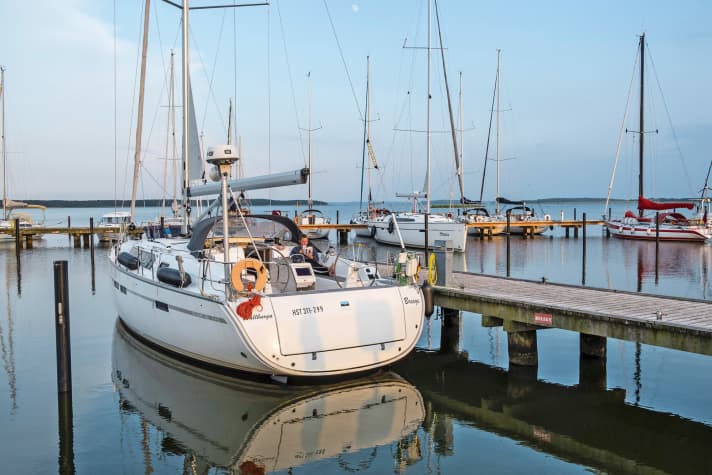
Breege is the ideal base from which to discover northern Rügen, which has so much to offer. The village is very sheltered in the north-western corner of the Bodden. The seaside resort of Juliusruh, situated on the outer coast of Rügen and spoilt with a wonderful beach, can be reached by saddle in just a few minutes. And then, after a refreshing swim on the supervised beach, you can continue along the Tromper Wiek shore path.
If you don't mind paying for an e-bike, you'll have to pedal hard, as the climb up Gorer Berg is 36 metres above sea level. Once you've managed that, you might want to stop off at the Hensen family's café on the steep bank, "Zur kleinen Rast", which is an insider tip that shouldn't really be publicised. They can hardly keep up with baking the delicious cakes since cycle tourism has been steadily increasing thanks to range-optimised bikes. For 21 years now, guests have been spoilt here in a beach chair with a view from the steep bank over the Baltic Sea.
Vitt is a gem that can almost be overlooked
This leads to the historic fishing village of Vitt, at the foot of Cape Arcona. The village is worth a visit if you discover it - because Vitt lies in the middle of a canyon, and you can only see it from land if you reach its edge. The former fish landing and trading centre was mentioned in documents as early as 1290.
Tobias Bredow is the fish smoker of Vitt. His hideaway is a gem on the beach, consisting of a jetty and slip, smokehouse with sales room and terrace. The whole thing is somewhat reminiscent of a Greek taverna, but you will only be anchored here when the wind is very calm from the west. The guests come by land. Bredow fishes and smokes his own fish and opens his shop every day at 2 pm. It closes when everything is sold out - and that can happen quickly, as he says.
If you still have time and desire, cycle on to Cape Arcona and look out over the Baltic Sea from the more than 40 metre high cliffs of the chalk cliffs, with good visibility as far as the island of Møn.
The good spirit of Vieregge
From Breege we continue outwards along the Bodden, this time heading south-west. Vieregge is on the way. In the pretty harbour village, which was built around the former loading pier, there are 50 moorings with modern sanitary facilities, a bathing beach and a small bistro. Klaus Schulz sits there at a table in front of a floor-to-ceiling window, his binoculars fixed on the water.
The former captain has signed on as a "barman" here - in fact, he is responsible for all sorts of things. Schulz collects harbour fees, sells bread rolls, operates the boat filling station and moors the passenger ship "Wappen von Breege" when it moors across the harbour entrance. The good spirit of the harbour comes from Lower Saxony and was stranded here by chance. "I'm a passionate catamaran sailor," says Schulz, explaining that he sought out the harbour for his boat and now lives here all year round.
From Vieregge, the next bay to pass through is Breetzer Bodden. On its southern shore, boats with a draught of less than 1.20 metres can anchor in Neuendorfer Wiek, a bay that extends deep into the land. Following the fairway, you finally pass the Wittow ferry, where there are also moorings for pleasure craft. However, these are only recommended in calm weather.
Wiek, the largest harbour on Rügen
Once you reach the Rassower Strom, you quickly head north-north-east towards Wiek. The pretty village is centred around an old church worth seeing, which was built by Cistercian monks in the 15th century. In the 19th century, Wiek was the largest village on the whole of Rügen.
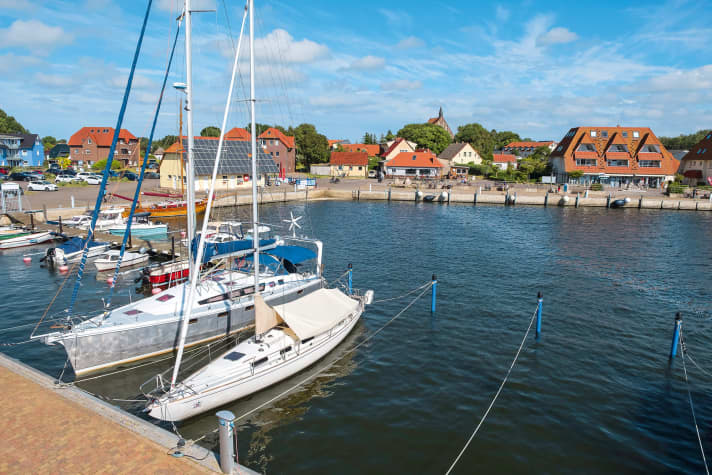
Today, it still has the largest harbour in the area - the only one in the Wieker Bodden that can be called at. Kuhle, one and a half nautical miles further north, is closed, and the jetty of the Wittow sailing club in Dranske has no places for guest sailors. Those who can still find accommodation will find a secluded club facility on land.
Wiek has a shipyard and a passenger ship to Hiddensee. The commercial harbour, built in 1890, is dominated by an old bridge that was built in 1914 to load chalk. However, it was never used. There are two harbour basins run by different operators. Both offer a very good service since the entire harbour area was renovated. The ruins of the bridge were converted into a promenade and the harbour master's office was built between the archways. There are restaurants and shops on the harbour promenade; the area is always lively in summer.
There are sailors who have spent their entire lives on the Bodden
Cycling tours across the Wittow peninsula, the "Windland", can also be undertaken from Wiek. To Kuhle, for example, because the small harbour is worth a visit despite being closed. Not least because it is home to "Schreiber's Fisch", a smokehouse with a large snack bar, where fish sandwiches and smoked fish delicacies are on the menu. In Dranske, the small local history museum is well worth a visit. Among other things, the museum explains the importance of the navy for the area, which once operated a large harbour here. The remains of the harbour can still be seen at the northern end of the Bug peninsula, as can the old residential blocks of the soldiers' families. This harbour is also closed, but offers excellent protection for anchors and is therefore explicitly designated as an anchorage bay in nautical literature.
Regardless of where you start from, a cycle tour along the Wieker Bodden should not be undertaken without a detour to the beach on the west coast of Rügen, just one kilometre away. Here you can enjoy a unique view over the open water. With a view of the Dornbusch. And the dead guy. Where the guest sailor can go back to sea once he has had his fill of the intoxicating landscape in the Bodden. Can - because there are sailors who have spent their lives here on the Bodden and never felt the urge to sail anywhere else.
Cruising tips Rügen Bodden
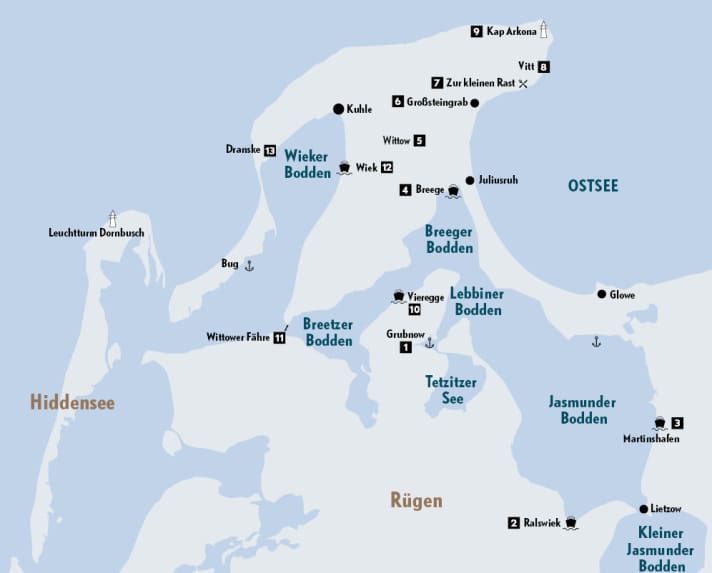
The precinct
The lagoons, bays and inlets in the northern part of Rügen are secluded, scenic and varied. Forests, fields and meadows line the shores. The shoreline is predominantly overgrown with dense reeds. Even though the waters are very sheltered, the larger bodies of water can be rough in windy conditions, as short, steep waves quickly form due to the shallow water depth. Only on the large Jasmund Bodden can you leave the well buoyed channels. Their courses often require a 90-degree change of course, which means that you may have to motor from time to time.
Harbours & anchorages
With a draught of up to two metres, the harbours of Wiek, Wittower Fähre, Vieregge, Breege, Ralswiek and Martinshafen are available. Anchoring is possible anywhere on the shore, depending on the wind direction, except for the southern part of the Bug peninsula, which is a protected zone. We particularly recommend the area in front of the former military harbour of Bug, the Lebbiner Bodden in front of Grubnow and the anchorage bay of Glowe.
Wind & Weather
Rügen is one of the places in Germany with the most hours of sunshine and the least rainfall. Average temperatures of more than 15 degrees can be expected in June, July and August. In midsummer, there can be consistently warm high-pressure weather, but the Atlantic lows can also bring cold and damp weather. The water temperature from around mid-June to the end of September is 17 degrees.
Charter
In Breege, Mola Yachting GmbH has around 70 charter yachts from 25 to 52 feet in length in its programme
Literature & Charts
- Jan Werner: "Törnführer Ostseeküste 2 - Wismar bis Stettin", 31.99 euros, order here
- Michael Brandenburg: "Küstenhandbuch Mecklenburg-Vorpommern - Travemünde bis Ueckermünde mit Rügen und den Boddengewässern", 39.90 euros, order here
- Emma Glaumann/Joakim Hermansson: "Hafenguide Flensburg- Danzig", 30 euros, order here
- DK-Sportbootkarten Set 2: "Mecklenburg-Vorpommern bis Bornholm mit Lübecker Bucht und Stettiner Haff", incl. area information, waypoint list, 115 harbour plans and approx. 40 aerial photos, 64.90 euros, order here
- Cockpit maps around Rügen, Edition Maritim 34,90 Euro, order here

